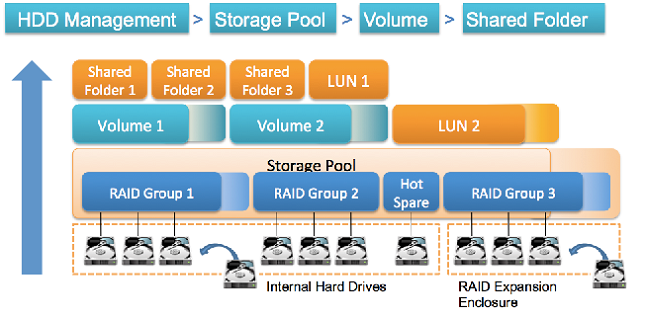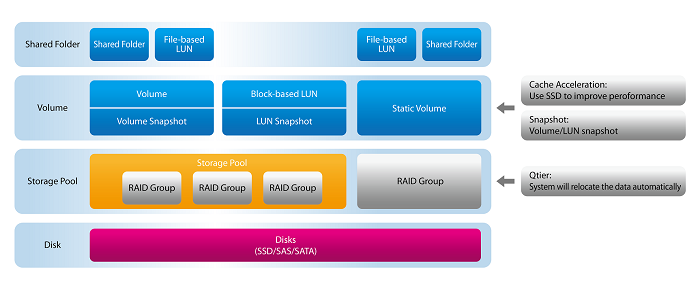Centralized Network Storage (NAS) Solution Deployment
Category: Server Solution
Project Overview
We specialize in deploying Centralized Network-Attached Storage (NAS) solutions across a wide variety of industries, including accounting firms, medical and healthcare organizations, construction companies, beauty salons, NGOs, retail businesses, and many others. Our goal is to enhance data management, improve collaboration, ensure data security, and enable scalability for organizations of all sizes.
We have successfully implemented NAS solutions for numerous clients, providing them with a centralized platform to store, access, and manage their data efficiently. Whether it’s handling sensitive patient records in healthcare, storing financial documents for accounting firms, or managing creative assets for retail and beauty companies, our solutions are designed to meet the unique requirements of each industry.

Project Phases
Phase 1: Initial Assessment and Planning
- Client Requirements Analysis:
- Engaged with stakeholders from various sectors to understand their specific needs, such as data storage volume, user access patterns, security requirements, and regulatory compliance.
- For accounting and healthcare clients, we focused on secure document management, backup solutions, and compliance with industry standards (e.g., HIPAA for healthcare).
- For retail, beauty, and NGO clients, we emphasized scalability, fast data access, and collaboration tools to support both onsite and remote teams.
- Current Infrastructure Review:
- Evaluated existing storage infrastructure and network capabilities to ensure the new NAS solution would integrate smoothly and support the organization’s growth.
- Regulatory Compliance:
- Ensured compliance with industry-specific regulations, such as HIPAA, GDPR, financial regulations for accounting firms, and other local data protection laws.
- Scope Definition:
- Defined clear project goals, timelines, and responsibilities, ensuring all stakeholders were aligned and expectations were set.
Phase 2. Preparation and Pre-Configuration
- Network Readiness:
- Verified that the client’s network could handle the increased load from centralized storage, including checking bandwidth and latency.
- Configured switches, VLANs, and network security settings to ensure high availability and optimal performance of the NAS system.
- Backup Plan:
- Created a robust data backup strategy to protect critical business data during and after the NAS deployment.
- User Communication:
- Informed users about the upcoming changes, provided an overview of the new system’s features, and prepared them for any required training or adjustments in workflows.
Phase 3. NAS Configuration
- Account Setup:
- Configured user accounts, setting permissions and roles based on organizational needs (e.g., admins, department heads, regular users).
- Storage Configuration:
- Partitioned the NAS into appropriate volumes for different use cases, such as secure storage for financial records or media management for retail and beauty clients.
- Configured RAID arrays for redundancy, ensuring high data availability and protection against hardware failure.
- Network Configuration:
- Ensured proper network settings (e.g., static IP addresses, DNS configurations) to ensure seamless integration with the organization’s existing infrastructure.
- Security & Compliance Setup:
- Implemented robust access controls and integrated the NAS system with Active Directory for centralized user authentication.
- Enabled encryption at rest and in transit to protect sensitive data, especially for medical, legal, and financial clients.
- Ensured compliance with relevant data protection regulations through automated backups, retention policies, and auditing features.
Phase 4. Advanced Features Setup
- High Availability (HA) and Data Redundancy:
- Set up high-availability configurations to ensure that critical data remains accessible, even in case of hardware failures.
- Snapshot and Versioning:
- Implemented automated snapshots to allow for quick recovery of files and folders in case of accidental deletion or data corruption.
- Enabled version control to track changes made to important documents, supporting both rollback and data recovery.
- Centralized Backup and Offsite Replication:
- Configured backup solutions that automatically back up NAS data to offsite locations or cloud storage, ensuring disaster recovery and long-term data retention.
Phase 5. Testing and Validation
- Initial Testing:
- Conducted performance testing to ensure optimal network speeds and file access times.
- Validated storage capacity and configurations to ensure the NAS met the company’s current and future needs.
- User Acceptance Testing (UAT):
- Involved a subset of users from different departments to validate that the system was easy to use and met business requirements.
- Security and Backup Testing:
- Ran simulated attacks and tests to verify that security features such as encryption, access control, and backup systems worked effectively.
- Performance Monitoring:
- Monitored the NAS system for any performance issues and ensured that the load did not impact the organization’s regular business operations.
Phase 6. User Training and Documentation
- Training Sessions:
- Delivered training sessions tailored to different user groups, covering how to use the new NAS system for file storage, collaboration, and recovery.
- Provided IT teams with specialized training on how to manage, maintain, and troubleshoot the system.
- Documentation:
- Supplied comprehensive documentation, including installation procedures, configuration guides, user manuals, and troubleshooting tips.
Phase 7. Go-Live and Post-Implementation Support
- Go-Live Preparation:
- Finalized all configurations and prepared for the transition to the new system, ensuring minimal disruption to daily operations.
- Go-Live Execution:
- Transitioned the client to the new NAS system, providing immediate support to address any issues or questions that arose during the transition.
- Post-Implementation Support:
- Provided ongoing support and regular system monitoring to address performance issues and fine-tune settings as needed.
- Set up a maintenance schedule for periodic health checks, backups, and updates.
Key Considerations
- Data Security and Compliance: Each solution was tailored to ensure adherence to data security best practices and compliance with industry-specific regulations (e.g., GDPR, HIPAA, financial regulations).
- User Experience: We ensured that users experienced minimal disruption during the transition, and provided thorough training and documentation to ensure a smooth adoption.
- Scalability: Our NAS solutions were designed to scale with the growth of each organization, easily accommodating more users and increasing data storage needs.
- Backup and Disaster Recovery: Robust backup systems and offsite replication were implemented to ensure that critical data could be recovered in the event of system failures.

Conclusion
We have successfully deployed centralized NAS solutions for a wide range of clients, including accounting firms, medical and healthcare organizations, construction companies, beauty salons, NGOs, and retail businesses. By customizing the solution to each organization’s unique needs, we have enhanced their data management capabilities, improved collaboration, and ensured their data is secure and scalable. Ongoing support and maintenance will ensure that these systems remain effective as clients continue to grow and evolve.
With our expertise and experience in deploying NAS systems, we provide organizations with reliable, secure, and cost-effective storage solutions that enable them to manage their data more efficiently and with greater peace of mind.



